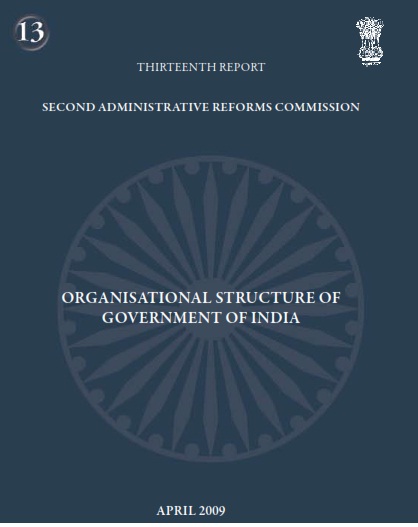(HOT) UPSC Current Affairs 2025 PDF
NEW! The Gist (NOV-2025) | E-BOOKS
(Report) 2nd Administrative Reforms Commission : Organisational Structure Of Government Of India

(Report) 2nd Administrative Reforms Commission :Organisational Structure Of Government Of India
Contents :
Chapter 1. Introduction 1
Chapter 2. Reorganising Government - International Experiences 4
2.1 Background 4
2.2 Models of Structural Reforms in Government 6
2.3 Origins of NPM 8
2.4 Reforms in Public Administation in UK 15
2.5 Reforms in Australia 18
2.6 Reforms in Thailand 20
2.7 Link between Governance and Growth 23
2.8 World Bank’s Recommendations for Improving 32
Governance Capacity
2.9 Lessons from Some Commonwealth Countries 35
2.10 Global Lessons 38
Chapter 3. Existing Structure of Government of India 46
3.1 Historical Background 46
3.2 The Constitutional Provisions 47
3.3 The Structure of a Department 49
3.4 Reforms since Independance 52
3.5 Strengths and Weaknesses of the Existing Structure 68
Chapter 4. Core Principles of Reforming the Structure of Government 71
Chapter 5. The Structure of Government of India at the Apex 74
5.1 Rationalising the Functions of Government 74
5.2 Rationalising the Size of Government 78
5.3 Reorganising the Ministries and Departments 79
5.4 Recasting the Allocation of Business Rules 97
5.5 Ministries and Departments to Primarily Focus on 103
Policy Analysis
5.6 Creation of Effective Executive Agencies 109
5.7 Internal Reorganisation of Ministries 119
5.8 Simplification of Governmental Processes 125
5.9 Recasting the Manual of Office Procedure 130
5.10 Coordination Mechanisms 134
5.11 Reducing Paperwork in Government Offices 138
Chapter 6. Creating an Effective Regulatory Framework 141
6.1 Introduction 141
6.2 Regulatory Functions 141
6.3 The Statutoty Independent Regulatory Agencies 144
6.4 Issues 149

